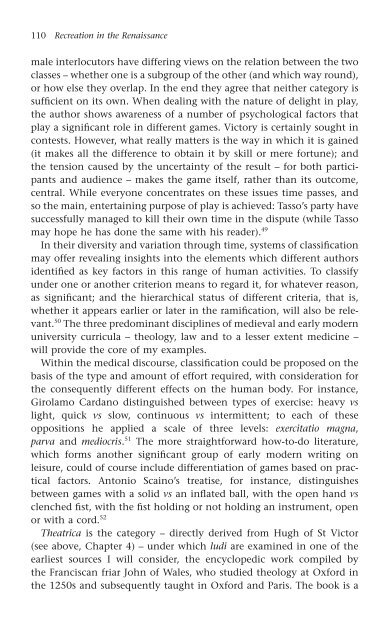Recreation in the Renaissance
Recreation in the Renaissance
Recreation in the Renaissance
- No tags were found...
You also want an ePaper? Increase the reach of your titles
YUMPU automatically turns print PDFs into web optimized ePapers that Google loves.
110 <strong>Recreation</strong> <strong>in</strong> <strong>the</strong> <strong>Renaissance</strong><br />
male <strong>in</strong>terlocutors have differ<strong>in</strong>g views on <strong>the</strong> relation between <strong>the</strong> two<br />
classes – whe<strong>the</strong>r one is a subgroup of <strong>the</strong> o<strong>the</strong>r (and which way round),<br />
or how else <strong>the</strong>y overlap. In <strong>the</strong> end <strong>the</strong>y agree that nei<strong>the</strong>r category is<br />
sufficient on its own. When deal<strong>in</strong>g with <strong>the</strong> nature of delight <strong>in</strong> play,<br />
<strong>the</strong> author shows awareness of a number of psychological factors that<br />
play a significant role <strong>in</strong> different games. Victory is certa<strong>in</strong>ly sought <strong>in</strong><br />
contests. However, what really matters is <strong>the</strong> way <strong>in</strong> which it is ga<strong>in</strong>ed<br />
(it makes all <strong>the</strong> difference to obta<strong>in</strong> it by skill or mere fortune); and<br />
<strong>the</strong> tension caused by <strong>the</strong> uncerta<strong>in</strong>ty of <strong>the</strong> result – for both participants<br />
and audience – makes <strong>the</strong> game itself, ra<strong>the</strong>r than its outcome,<br />
central. While everyone concentrates on <strong>the</strong>se issues time passes, and<br />
so <strong>the</strong> ma<strong>in</strong>, enterta<strong>in</strong><strong>in</strong>g purpose of play is achieved: Tasso’s party have<br />
successfully managed to kill <strong>the</strong>ir own time <strong>in</strong> <strong>the</strong> dispute (while Tasso<br />
may hope he has done <strong>the</strong> same with his reader). 49<br />
In <strong>the</strong>ir diversity and variation through time, systems of classification<br />
may offer reveal<strong>in</strong>g <strong>in</strong>sights <strong>in</strong>to <strong>the</strong> elements which different authors<br />
identified as key factors <strong>in</strong> this range of human activities. To classify<br />
under one or ano<strong>the</strong>r criterion means to regard it, for whatever reason,<br />
as significant; and <strong>the</strong> hierarchical status of different criteria, that is,<br />
whe<strong>the</strong>r it appears earlier or later <strong>in</strong> <strong>the</strong> ramification, will also be relevant.<br />
50 The three predom<strong>in</strong>ant discipl<strong>in</strong>es of medieval and early modern<br />
university curricula – <strong>the</strong>ology, law and to a lesser extent medic<strong>in</strong>e –<br />
will provide <strong>the</strong> core of my examples.<br />
With<strong>in</strong> <strong>the</strong> medical discourse, classification could be proposed on <strong>the</strong><br />
basis of <strong>the</strong> type and amount of effort required, with consideration for<br />
<strong>the</strong> consequently different effects on <strong>the</strong> human body. For <strong>in</strong>stance,<br />
Girolamo Cardano dist<strong>in</strong>guished between types of exercise: heavy vs<br />
light, quick vs slow, cont<strong>in</strong>uous vs <strong>in</strong>termittent; to each of <strong>the</strong>se<br />
oppositions he applied a scale of three levels: exercitatio magna,<br />
parva and mediocris. 51 The more straightforward how-to-do literature,<br />
which forms ano<strong>the</strong>r significant group of early modern writ<strong>in</strong>g on<br />
leisure, could of course <strong>in</strong>clude differentiation of games based on practical<br />
factors. Antonio Sca<strong>in</strong>o’s treatise, for <strong>in</strong>stance, dist<strong>in</strong>guishes<br />
between games with a solid vs an <strong>in</strong>flated ball, with <strong>the</strong> open hand vs<br />
clenched fist, with <strong>the</strong> fist hold<strong>in</strong>g or not hold<strong>in</strong>g an <strong>in</strong>strument, open<br />
or with a cord. 52<br />
Theatrica is <strong>the</strong> category – directly derived from Hugh of St Victor<br />
(see above, Chapter 4) – under which ludi are exam<strong>in</strong>ed <strong>in</strong> one of <strong>the</strong><br />
earliest sources I will consider, <strong>the</strong> encyclopedic work compiled by<br />
<strong>the</strong> Franciscan friar John of Wales, who studied <strong>the</strong>ology at Oxford <strong>in</strong><br />
<strong>the</strong> 1250s and subsequently taught <strong>in</strong> Oxford and Paris. The book is a










